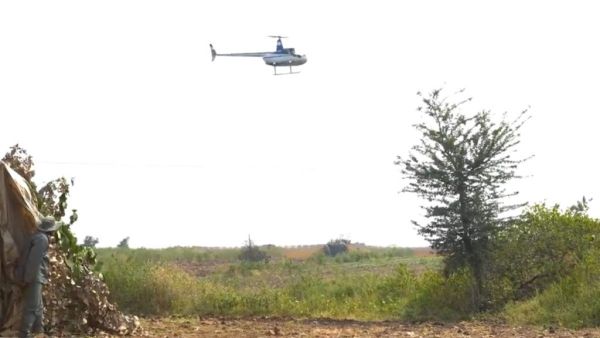
Madhya Pradesh’s forest department has initiated an innovative campaign employing helicopters and the Boma technique to address crop damage caused by blackbucks and blue bulls, especially in the western regions of the state. This is being done in collaboration with conservation experts from South Africa.
The Boma technique is a method of wildlife capture and translocation that uses a funnel-like enclosure to safely move animals without chemical immobilisation. Animals are herded by foot or helicopter into a V-shaped fence, which narrows into an opaque loading chute. This non-invasive technique minimises stress and injury to the animals.
On Friday, a Boma trap was installed in Lahori Badla village of Shajapur district as part of this effort. As many as 59 blue bulls were trapped from the area and released into the forests of national parks.
So far, the campaign has successfully trapped 501 blackbucks and 59 blue bulls and relocated them to protected forest areas and national parks. This initiative is expected to reduce crop damage for farmers and provide a solution to their long-standing problems. This is the first campaign of its kind in India.
The forest department has formed a dedicated field team, trained alongside the South African conservation team, and will continue to conduct capture operations for blackbucks and blue bulls. The campaign is also receiving support from the public.
Villagers have been requested by the forest department not to chase the animals during helicopter-driven herding operations to ensure the safety of both wildlife and people. The campaign will continue until the first week of November. The aim is to provide relief to farmers by controlling the wildlife population responsible for agricultural damage.
Though specific data is not available, crop damage by wild animals is a significant and widespread problem in the state. On average, 21-22 incidents of crop raiding occur per month, with seasonal variations (higher during the Kharif and Rabi seasons).
The most problematic animals reported are wild boars (involved in 100 per cent of cases in one study), followed by blue bulls (nilgai) and sometimes stray cattle. Nilgais in the Mandsaur region have been reported to be addicted to opium and cause extensive damage.
The crops most affected are corn, wheat, gram, sugarcane, pulses, and soybeans. One study has indicated that up to 40.56 per cent of the soybean area was prone to animal menace.
Another study estimated an average loss of Rs 25,358 per farm. This includes loss of crops and increased cultivation costs, as watch and ward/fencing have to be put up.
-
DPDP Rules Mark Significant Milestone In India’s Ongoing Data Protection Journey Technology News

-
An invitation for cybercriminals or negligence on the part of companies? Satellite links are vulnerable, easily leaking government and personal data

-
Curry Matches Jordan’s Record, Drops 49 on Spurs

-
Who Is Carlos Alcaraz’s Girlfriend? Tennis Star Breaks Silence at ATP Finals

-
What is the secret of Vaibhav Suryavanshi’s six hitting? Bowlers are afraid to face him; Read in detail
